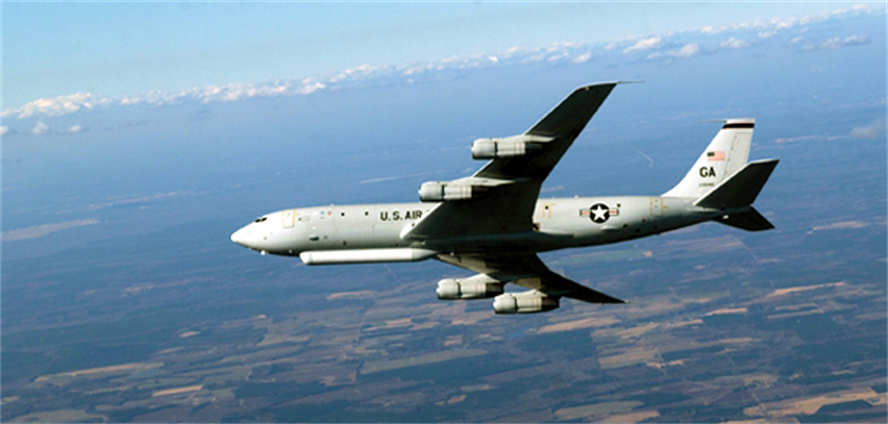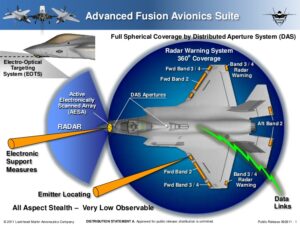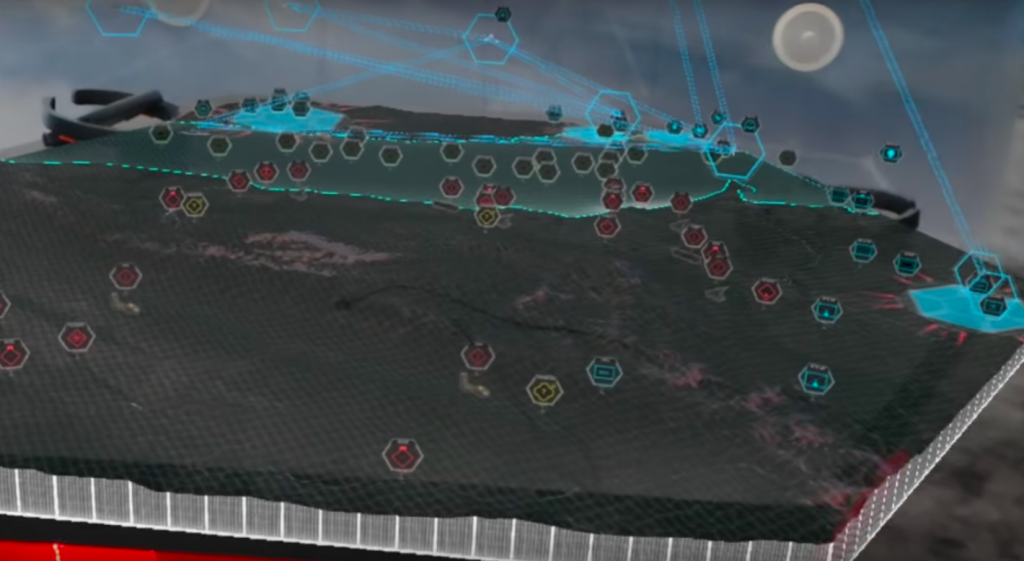
E-8C JSTARS
WASHINGTON: Build it and they will come. That, in essence, is how the Air Force plans to get the Army, Navy, and Marines on board with its plan for a comprehensive Advanced Battle Management System to move data at machine speed across the globe — from subs to satellites, from aircraft to ground troops, and from ships to shore.
The catch? This vision is not only extremely ambitious, it’s also still quite vague – and critics in Congress are worried that ABMS, which is running behind schedule, was already too ambitious and too vague even when it was just trying to connect different systems within the Air Force.
ABMS originally stood for Airborne Battle Management System and referred to the mission long performed by the E8-C JSTARS fleet: Boeing 707s modified to carry powerful radars for ground and air surveillance, plus the technicians and communications to relay reports of enemy positions across the force. The data JSTARS provides is highly prized, but the aircraft themselves are old, lumbering and highly vulnerable. So the Air Force wanted to exploit modern electronic communications and miniaturization to replace JSTARS with a whole network of different sensors on satellites, manned aircraft, and drones.
That task is hard enough. Trying to pull in data from even more kinds of sensors and transmitting it to an even wider range of customers is going to be much harder.
But if – if – the Air Force can get this ambitious architecture to actually work, it could become the indispensable digital nervous system of the future fight. By connecting all four services’ forces in all five domains of war – air, land, sea, space, and cyberspace – such a Multi-Domain or All-Domain Command & Control (MDC2) system could make possible new kinds of high-speed, seamlessly coordinated combat operations that would give the US a much-needed edge against Russia and China.

Air Force Chief Architect Preston Dunlap (left) and Brig. Gen. David Kumashiro (right) at the Defense One Outlook 2020 conference.
The General & The Architect
The Air Force approach is pretty clear. ABMS will be “the technical engine” driving the Air Force’s approach to MDC2, said Brig. Gen. David Kumashiro, who works for Air Force Chief of Staff Gen. David Goldfein as director of joint force integration.
The Navy talks about Distributed Maritime Operations, the Army about Multi-Domain Operations and the Joint Staff about Joint All-Domain C2, noted Preston Dunlap, who as the Air Force’s recently appointed Chief Architect is primarily responsible for ABMS. “The nice thing is everybody’s rolling in the same direction,” he said, speaking alongside Kumashiro at yesterday’s Defense One conference.
[Read Dunlap’s plan to get the F-22 and F-35 talking at long last]
But how, I asked, can the Air Force convince the other services and even its own acquisition program managers to come aboard and make their systems compatible?
Dunlap is fervently pursuing two paths. “What we’re doing is evangelistic sort of talks like this to make sure that everybody understands the path,” he said. Second, next month he will launch a series of “very visible” field experiments that will build on one another rapidly over time, he said: “We want to do this religious[ly] every four months.”
“One of the products that we’re developing and pushing — we’ll get an initial instance here in December as well — I call it Omni One,” Dunlap said. “The idea is that all [services] see the same picture we’re talking about for space and air and land and surface and cyber.” Imagine a digital map like Wayz or Uber, he said, showing all the different warships, ground vehicles, and aircraft in real time, with the ability to click on any icon and see exactly what it is and where it’s going.

F-35 sensors
The Air Force already has a cloud-based system for tracking aircraft and targets that will be tested in December, he said. “Being able to pass that [data] down to troops on the ground is another piece,” Dunlap told me after the session. “It should be [ready] in December” for an initial test, he said.
As Dunlap and other Air Force experimenters show the art of the possible, one important incentive for the other services to come aboard is “the FOMO effect — the fear of missing out,” Kumashiro said. “If you’re not established on this environment, if you don’t expose your data in an open manner, that you don’t follow the standards of an open systems architecture, you’re going to find yourself off on the sidelines and not being relevant to the fight.”
Today, troops from different branches can usually talk to one another over the radio, but that’s a slow and error-prone way of relaying detailed data like the locations of friendly forces and hostile targets. (And it’s a matter of life or death to avoid getting those two things mixed up). The military has multiple systems for transmitting data directly from one computer to another – machine to machine – over radio and landline, but each focuses on a specific function, like navigation, logistics, or artillery planning, and they don’t connect with other systems in the same service, let alone with those of other services. All too often data has to be laboriously retyped by hand, or simply scrawled on sticky notes and passed from one staff officer to the next.
“We don’t have that machine to machine connection,” Kumashiro said. “So that’s one of the other areas that we will specifically target as we build out this Advanced Battle Management System, which is really what I would call the technical engine behind our particular Multi-Domain Command & Control [approach], ensuring that Army systems, Navy systems, Air Force systems speak to each other.”
“The capabilities that we’re building and using, we’re actually designing into it the capability to snap together like Lego blocks, both our Air Force capabilities as well as our sister services and international partners,” Dunlap said. “The service secretaries all jointly signed a memo this past year that reinforced the requirement that we all operate on and work from a certain set of standards, [and] we’re continuing to grow those standards.”

Raytheon Multi-Domain Command & Control (MDC2) concept
The Hard Part
Now, agreeing on a common set of technical standards is just one step towards building something that complies with those standards and actually works. Civilian consumers are used to their smartphones working everywhere they go, switching automatically from network to network, and providing everything from the latest music to real-time navigation around traffic jams. But, Dunlap noted, that ease of use is built on top of decades of hard work and heavy investment in an infrastructure of towers, routers, servers, and so on.
“What we have generally not done in the defense tech community is a really focused effort to invest in all the steps that have to happen,” Dunlap said. “We want connectivity, we want artificial intelligence, [but] you can’t jump to an end state” without doing all the other steps first, he said: That’s “like asking a baby to drive a car.”
Such frank talk is unlikely to reassure Congress. Although the final National Defense Authorization Act for 2020 has not yet been negotiated between the House and Senate, both chambers sounded notes of caution on the Advanced Battle Management System.
“The fiscal year 2019 budget request for the Air Force cancelled the long-planned Joint Surveillance Target Attack Radar System [JSTARS] recapitalization and included a small amount of funding in existing programs as a bridge to a new concept for comprehensive battle management command and control…the Advanced Battle Management System,” the House Armed Services Committee wrote in its report. “[But] the budget request provided limited programmatic details on ABMS. The committee is concerned with the lack of discernible benchmarks to assess and measure progress.” The committee demanded detailed documentation “not later than 180 days” after the Air Force completed its official Analysis of Alternatives for ABMS – an analysis now well behind schedule.
The Senate, for its part, said the ABMS concept was impressive but worried it might take so long to realize that it wouldn’t be ready before the aging JSTARS fleet had to retire. “The committee is supportive of the Air Force’s vision for the ABMS as a system of systems that can integrate and fuse data from disaggregated sensors,” the Senate Armed Services Committee wrote. “However, the committee remains concerned about the speed of fielding based on the current projected end of life for the Joint Surveillance and Target Attack Radar System aircraft.”
At the moment, the Air Force has no program to build a new JSTARS aircraft and very little funding to develop ABMS. Now, there is a lot that can and should be done before dumping piles of money into building anything: the highly technical, unsexy work to define data architecture and standards, for instance, or the small-scale, high-payoff experiments that Dunlap hopes will have a lot of sex appeal to garner support. But before the Advanced Battle Management System can move from concept to reality, the Air Force has to convince Congress and its fellow services that the investment will pay off.
Colin & Theresa contributed to this story.






















